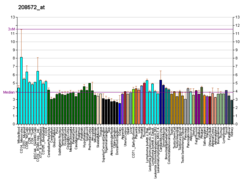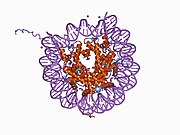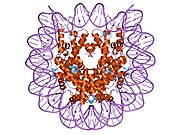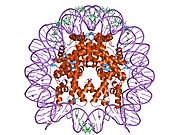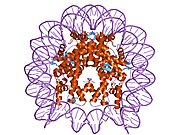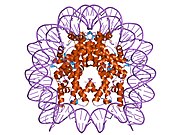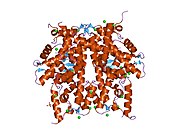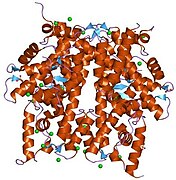| H3-4 | |||||||||||||||||||||||||||||||||||||||||||||||||||
|---|---|---|---|---|---|---|---|---|---|---|---|---|---|---|---|---|---|---|---|---|---|---|---|---|---|---|---|---|---|---|---|---|---|---|---|---|---|---|---|---|---|---|---|---|---|---|---|---|---|---|---|
 | |||||||||||||||||||||||||||||||||||||||||||||||||||
| |||||||||||||||||||||||||||||||||||||||||||||||||||
| Identifiers | |||||||||||||||||||||||||||||||||||||||||||||||||||
| Aliases | H3-4, H3.4, H3/g, H3FT, H3t, histone cluster 3, H3, histone cluster 3 H3, HIST3H3, H3.4 histone | ||||||||||||||||||||||||||||||||||||||||||||||||||
| External IDs | OMIM: 602820; HomoloGene: 133212; GeneCards: H3-4; OMA:H3-4 - orthologs | ||||||||||||||||||||||||||||||||||||||||||||||||||
| |||||||||||||||||||||||||||||||||||||||||||||||||||
| |||||||||||||||||||||||||||||||||||||||||||||||||||
| |||||||||||||||||||||||||||||||||||||||||||||||||||
| |||||||||||||||||||||||||||||||||||||||||||||||||||
| Wikidata | |||||||||||||||||||||||||||||||||||||||||||||||||||
| |||||||||||||||||||||||||||||||||||||||||||||||||||
Histone H3.1t is a protein that in humans is encoded by the HIST3H3 gene.
Histones are basic nuclear proteins that are responsible for the nucleosome structure of the chromosomal fiber in eukaryotes. Nucleosomes consist of approximately 146 bp of DNA wrapped around a histone octamer composed of pairs of each of the four core histones (H2A, H2B, H3, and H4). The chromatin fiber is further compacted through the interaction of a linker histone, H1, with the DNA between the nucleosomes to form higher order chromatin structures. This gene is intronless and encodes a member of the histone H3 family. Transcripts from this gene lack polyA tails; instead, they contain a palindromic termination element. This gene is located separately from the other H3 genes that are in the histone gene cluster on chromosome 6p22-p21.3.
References
- ^ ENSG00000285435 GRCh38: Ensembl release 89: ENSG00000168148, ENSG00000285435 – Ensembl, May 2017
- "Human PubMed Reference:". National Center for Biotechnology Information, U.S. National Library of Medicine.
- Albig W, Ebentheuer J, Klobeck G, Kunz J, Doenecke D (Dec 1996). "A solitary human H3 histone gene on chromosome 1". Hum Genet. 97 (4): 486–91. doi:10.1007/BF02267072. PMID 8834248. S2CID 27799958.
- Marzluff WF, Gongidi P, Woods KR, Jin J, Maltais LJ (Oct 2002). "The human and mouse replication-dependent histone genes". Genomics. 80 (5): 487–98. doi:10.1016/S0888-7543(02)96850-3. PMID 12408966.
- "Entrez Gene: HIST3H3 histone cluster 3, H3".
Further reading
- Govin J, Caron C, Rousseaux S, Khochbin S (2005). "Testis-specific histone H3 expression in somatic cells". Trends Biochem. Sci. 30 (7): 357–9. doi:10.1016/j.tibs.2005.05.001. PMID 15922600.
- Bernués J, Espel E, Querol E (1986). "Identification of the core-histone-binding domains of HMG1 and HMG2". Biochim. Biophys. Acta. 866 (4): 242–51. doi:10.1016/0167-4781(86)90049-7. PMID 3697355.
- Ishimi Y, Ichinose S, Omori A, et al. (1996). "Binding of human minichromosome maintenance proteins with histone H3". J. Biol. Chem. 271 (39): 24115–22. doi:10.1074/jbc.271.39.24115. PMID 8798650.
- Mizzen CA, Yang XJ, Kokubo T, et al. (1997). "The TAF(II)250 subunit of TFIID has histone acetyltransferase activity". Cell. 87 (7): 1261–70. doi:10.1016/S0092-8674(00)81821-8. PMID 8980232. S2CID 18409257.
- Witt O, Albig W, Doenecke D (1997). "Testis-specific expression of a novel human H3 histone gene". Exp. Cell Res. 229 (2): 301–6. doi:10.1006/excr.1996.0375. PMID 8986613.
- Rodriguez P, Munroe D, Prawitt D, et al. (1997). "Functional characterization of human nucleosome assembly protein-2 (NAP1L4) suggests a role as a histone chaperone". Genomics. 44 (3): 253–65. doi:10.1006/geno.1997.4868. PMID 9325046.
- Albig W, Doenecke D (1998). "The human histone gene cluster at the D6S105 locus". Hum. Genet. 101 (3): 284–94. doi:10.1007/s004390050630. PMID 9439656. S2CID 38539096.
- El Kharroubi A, Piras G, Zensen R, Martin MA (1998). "Transcriptional activation of the integrated chromatin-associated human immunodeficiency virus type 1 promoter". Mol. Cell. Biol. 18 (5): 2535–44. doi:10.1128/mcb.18.5.2535. PMC 110633. PMID 9566873.
- Zhang Y, Sun ZW, Iratni R, et al. (1998). "SAP30, a novel protein conserved between human and yeast, is a component of a histone deacetylase complex". Mol. Cell. 1 (7): 1021–31. doi:10.1016/S1097-2765(00)80102-1. PMID 9651585.
- Lorain S, Quivy JP, Monier-Gavelle F, et al. (1998). "Core histones and HIRIP3, a novel histone-binding protein, directly interact with WD repeat protein HIRA". Mol. Cell. Biol. 18 (9): 5546–56. doi:10.1128/MCB.18.9.5546. PMC 109139. PMID 9710638.
- Becker W, Weber Y, Wetzel K, et al. (1998). "Sequence characteristics, subcellular localization, and substrate specificity of DYRK-related kinases, a novel family of dual specificity protein kinases". J. Biol. Chem. 273 (40): 25893–902. doi:10.1074/jbc.273.40.25893. PMID 9748265.
- Carrier F, Georgel PT, Pourquier P, et al. (1999). "Gadd45, a p53-responsive stress protein, modifies DNA accessibility on damaged chromatin". Mol. Cell. Biol. 19 (3): 1673–85. doi:10.1128/MCB.19.3.1673. PMC 83961. PMID 10022855.
- Sassone-Corsi P, Mizzen CA, Cheung P, et al. (1999). "Requirement of Rsk-2 for epidermal growth factor-activated phosphorylation of histone H3". Science. 285 (5429): 886–91. doi:10.1126/science.285.5429.886. PMID 10436156.
- Thomson S, Clayton AL, Hazzalin CA, et al. (1999). "The nucleosomal response associated with immediate-early gene induction is mediated via alternative MAP kinase cascades: MSK1 as a potential histone H3/HMG-14 kinase". EMBO J. 18 (17): 4779–93. doi:10.1093/emboj/18.17.4779. PMC 1171550. PMID 10469656.
- Hsieh YJ, Kundu TK, Wang Z, et al. (1999). "The TFIIIC90 subunit of TFIIIC interacts with multiple components of the RNA polymerase III machinery and contains a histone-specific acetyltransferase activity". Mol. Cell. Biol. 19 (11): 7697–704. doi:10.1128/mcb.19.11.7697. PMC 84812. PMID 10523658.
- Cheung P, Tanner KG, Cheung WL, et al. (2000). "Synergistic coupling of histone H3 phosphorylation and acetylation in response to epidermal growth factor stimulation". Mol. Cell. 5 (6): 905–15. doi:10.1016/S1097-2765(00)80256-7. PMID 10911985.
- Buggy JJ, Sideris ML, Mak P, et al. (2001). "Cloning and characterization of a novel human histone deacetylase, HDAC8". Biochem. J. 350 (1): 199–205. doi:10.1042/0264-6021:3500199. PMC 1221242. PMID 10926844.
- Deng L, de la Fuente C, Fu P, et al. (2001). "Acetylation of HIV-1 Tat by CBP/P300 increases transcription of integrated HIV-1 genome and enhances binding to core histones". Virology. 277 (2): 278–95. doi:10.1006/viro.2000.0593. PMID 11080476.
- Seo SB, McNamara P, Heo S, et al. (2001). "Regulation of histone acetylation and transcription by INHAT, a human cellular complex containing the set oncoprotein". Cell. 104 (1): 119–30. doi:10.1016/S0092-8674(01)00196-9. PMID 11163245. S2CID 11144887.
This article on a gene on human chromosome 1 is a stub. You can help Misplaced Pages by expanding it. |


